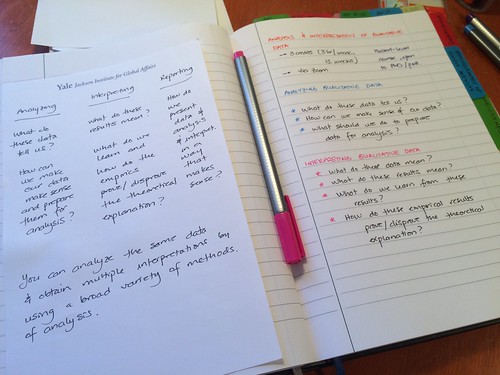I have been teaching graduate-level courses for a very long time now, but my methods teaching has increased several times over because I am now associated with FLACSO’s Methods Lab, so my teaching load is much more focused on methodological pedagogy. Over the past year I’ve taught Comparative Methods, Qualitative Methods, Research Design, Research Methodology, Thesis Seminar, Mixed Methods. This Spring, I was asked by my students and colleagues to design a “Qualitative Data Analysis and Interpretation” course for Masters and Doctoral candidates and potentially faculty who might be interested in the topic.
In this post, I am going to share with you a few insights I learned from designing (from scratch) a qualitative methods course. Disclosure: I was the Editor for the Americas of the International Journal of Qualitative Methods. I apply qualitative methods in my research (though I am a mixed methods person and feel equally comfortable with quantitative methods). I teach qualitative methods. I write and publish methods pieces.
All this is to say: I’m most definitely not a newbie to the field/to the methods. Nevertheless, despite NOT being a newcomer, I invested a lot of time and money preparing to design this course.
Preparing syllabi is HARD and takes a lot of time and effort.
In order for me to properly design a “Qualitative Data Analysis and Interpretation” Masters/PhD level course, I:
– went and read (and in some cases, re-read) 31 books.
– emailed two professor friends who shared their syllabi with me.
– downloaded and read 15 different syllabi.
I invested more than 60 hours of my life JUST thinking through which readings and in which order, and which activities I was going to implement. Obviously, it also took me a few hours (4-6) to write the actual syllabus.
What did I learn, after all this?
Well, this will be no news to qualitative researchers, but IT’S FREAKING HARD TO DESIGN A QUALITATIVE METHODS SYLLABUS. There are so many different ways in which I could slice and dice this course. I could craft a 3 semesters sequence (basic, intermediate, advanced).
For my “ethnography in comparative policy analysis” chapter, I read 20 books. 20 ethnographies. https://t.co/6f9UyMTXUU
Teaching a semester-long seminar on ethnography (just the mere basics) would require me to eschew some of these incredible works, pick-and-choose.
— Dr Raul Pacheco-Vega (@raulpacheco) July 4, 2021
I could teach a 3-semesters-long sequence on ethnography alone. And that would *just* scratch the surface. I have considered teaching “Foundations of Ethnography”, “Intermediate Ethnography” and “Advanced Topics in Ethnography” and I still have a lot more books to assign than I could cover in any course.
I’ve read 32 books JUST on fieldwork, JUST to think through the mere idea of how to teach students how to enter the field, how to collect data, how to protect themselves.
My point: EVERY course on qualitative methods is bound to miss stuff. You can teach “the mere basics”, a survey, that then gives students the opportunity to develop a specific analytic technique, epistemological and ontological approach. But no course is going to cover EVERYTHING.
In my view, it’s a good idea to teach AT LEAST ONE COURSE in qualitative methods, but we need to be keenly aware and cognizant that there will be gaps that we haven’t filled and that there are new developments that won’t show up in our syllabi on time.
That’s ok too.
Obviously, I still believe we need to be rigorous in what we teach and how we teach in qualitative methods https://t.co/8iTqEedxbH
This is perhaps the most important insight I’ve gained after teaching several sequences of Research Design, Comparative Methods, Mixed Methods.
— Dr Raul Pacheco-Vega (@raulpacheco) July 4, 2021
Whatever you teach, make sure you include rigorous and well-crafted exemplars that your students and you can deconstruct in class and learn from. That’s one key lesson that I have learned after teaching undergraduate, Masters and PhD-level courses.


0 Responses
Stay in touch with the conversation, subscribe to the RSS feed for comments on this post.